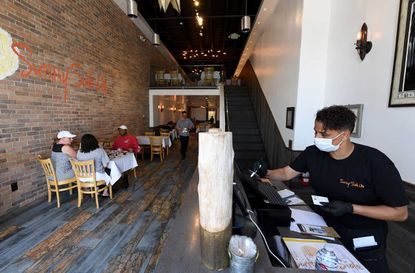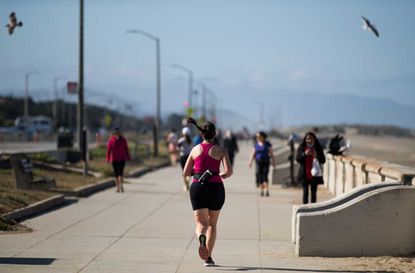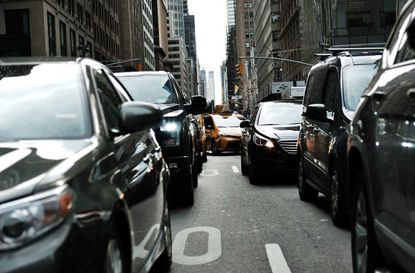7 Ways the Pandemic Will Change Big U.S. Cities
Historically, pandemics transform cities.


Historically, pandemics transform cities. Outbreaks of cholera and other diseases, for example, spurred improvements in planning and sanitation throughout the 19th and early 20th centuries. COVID-19 will also leave a lasting impact, in part by accelerating preexisting trends.
In the short term, cities will likely suffer as the virus highlights the disadvantages of dense urban spaces. Even before COVID-19, population growth in urban counties had flatlined. Several factors will favor the suburbs—some old (the lower cost of living, for example) and some new (an increase in telework).
So, will COVID-19 usher in a new era of de-urbanization? Not necessarily. Indeed, cities may be in the best position to lead the economic recovery after the pandemic, much as they did after the Great Recession. “Superstar” cities with strong tech industries like San Francisco and Seattle will likely rebound the fastest.
Read on to discover seven post-pandemic developments to expect in big cities across America.

To continue reading this article
please register for free
This is different from signing in to your print subscription
Why am I seeing this? Find out more here

Many of Your Favorite Restaurants Will Disappear
The devastation of the retail and restaurant sectors, both key sources of jobs and tax revenues for cities, will be particularly painful. One in five restaurants could permanently close because of the pandemic. Stores and eateries that remain will look and feel different, with limits on the number of customers allowed inside and lots of physical dividers.
Long term, the pandemic will help accelerate the hybridization and consolidation of retail. In the future, more stores will double as (or share space with) restaurants and coffee shops, catering to customers’ growing desire for experiences as well as goods.
Even before COVID-19, the U.S. had a massive surplus of shopping real estate, with anywhere from 23.5 to 46.6 square feet of retail space per person (versus 2.4 square feet per person in Germany and 1.5 square feet per person in Mexico). Expect some of that space to be repurposed as lifestyle and recreation centers, even housing.

Many Downtown Offices Will Remain Vacant
Office and retail vacancy rates will spike and may stay elevated for the next few years, depending on the pace of the economic recovery. Companies will likely continue reducing their office footprint as a growing number of employees work from home. Fewer workers downtown will further compound the pain of city restaurant and retail sectors, slowing their recovery.
As with retail, unused office space may also be converted to residential, helping to ease the current shortage of affordable housing in urban areas.

Bracelets for Office and Factory Workers
The next office fashion trend? Electronic bracelets or smartwatches that buzz whenever workers get too close to each other. That’s just one example of the hardware employers will use to ensure social distancing and allow for “contact tracing” of COVID-19 in the workplace. Another: location tracking systems, so employers can retrace the steps of workers who contract the virus and determine who else may be at risk.
Other features of the post-pandemic workplace: Regular temperature checks. More physical barriers between workers. The cubicle may be poised for a comeback, especially as open floor plans—now a feature in seven of 10 offices—become deeply unpopular.

Big Cities: Still Home to the Fastest-Growing Jobs
Suburban job growth has outpaced urban job growth for decades. But in the long term, urban areas have the mix of jobs projected to grow the fastest over the next decade, including medical and life scientists and software developers.
Again, cities may lose some of these jobs to telework. Others may eventually shift to the suburbs as employers pursue lower costs—but most will not. Tech-sector jobs, for example, are highly concentrated in urban areas to take advantage of network effects.

More Traffic Congestion
There may be fewer workers coming downtown each weekday in the future, but there could be more cars. Americans will likely be shunning public transit for private vehicles, making traffic congestion worse as economic activity resumes.
Rail systems in Chicago, San Francisco and New York, for example, have seen ridership decline by 90% or more since the start of the pandemic. Bus ridership has also tumbled, though it held up better than rail because it depends less on suburban commuters.

Smaller Crowds at Concerts and Sporting Events
Concerts and sporting events will be less crowded, with limits on the number of people per venue—when they finally happen again. At the very least, expect more empty seats and hand sanitizer stations everywhere. Some public health experts have also proposed temperature checks for fans before they enter.
Still, even as major sports leagues consider plans to resume play—the NFL, for example, is hoping is hoping the 2020 season will proceed as planned this fall, with fans in stadiums—most Americans say they don’t want to go to games until a vaccine is widely available.

Tech Will Take Over
Technology essential to coping with the virus will only grow in prominence, from online grocery delivery to urban informatics. That's the practice of gleaning insights from big data to make policy decisions, now a tool to “test and trace” the spread of COVID-19.
Globally, so-called “urban tech” is a $65 billion industry, with the U.S. accounting for roughly a third of all such investment. While some segments of urban tech will struggle after COVID-19, most notably coworking spaces such as WeWork, others will thrive. Even ride-sharing services such as Uber, while hard hit now, could ultimately benefit from people’s wariness of public transportation.
But however useful, expect many of these new tools to raise privacy concerns.

-
 GM Stock Accelerates After Earnings Beat
GM Stock Accelerates After Earnings BeatGeneral Motors beat expectations for the first quarter and raised its outlook for the year. Here's what you need to know.
By Joey Solitro Published
-
 Georgia Has a New Income Tax Rate for 2024
Georgia Has a New Income Tax Rate for 2024Tax Cuts Georgians now have a tax package containing income tax cuts, childcare relief, and potential property tax caps.
By Kelley R. Taylor Published
-
 The Robots Are Coming... But Not For a While
The Robots Are Coming... But Not For a WhileThe Kiplinger Letter There’s excitement in the tech sector over the potential of humanoid robots, but widespread adoption is likely to be years away.
By John Miley Published
-
 Farmers Face Another Tough Year As Costs Continue to Climb: The Kiplinger Letter
Farmers Face Another Tough Year As Costs Continue to Climb: The Kiplinger LetterThe Kiplinger Letter Farm income is expected to decline for a second year, while costs continue to up-end farm profitability.
By Matthew Housiaux Published
-
 H-1B Work Visa Rules Get a Revamp
H-1B Work Visa Rules Get a RevampThe Kiplinger Letter H-1B visas allow employers to hire high-skilled foreign workers. Regulators have finalized new rules for this visa program following last fall's proposal.
By Matthew Housiaux Published
-
 Woes Continue for Banking Sector: The Kiplinger Letter
Woes Continue for Banking Sector: The Kiplinger LetterThe Kiplinger Letter Regional bank stocks were hammered recently after news of New York Community Bank’s big fourth-quarter loss.
By Rodrigo Sermeño Published
-
 Are College Athletes Employees of Their Schools?: The Kiplinger Letter
Are College Athletes Employees of Their Schools?: The Kiplinger LetterThe Kiplinger Letter A recent ruling has ramifications for labor relations and the unionization of student athletes.
By Sean Lengell Published
-
 Salton Sea Clean Energy and Lithium Project Gets Approval: The Kiplinger Letter
Salton Sea Clean Energy and Lithium Project Gets Approval: The Kiplinger LetterThe Kiplinger Letter California's Salton Sea is due to see the construction of a new lithium extraction and geothermal clean energy power plant.
By Matthew Housiaux Published
-
 More Woes for Anheuser-Busch as a Strike Looms: The Kiplinger Letter
More Woes for Anheuser-Busch as a Strike Looms: The Kiplinger LetterThe Kiplinger Letter Drinkers of Anheuser-Busch beers may want to stock up soon. A looming strike threatens to shutter its U.S. breweries later this month.
By Sean Lengell Published
-
 The Auto Industry Outlook for 2024
The Auto Industry Outlook for 2024The Kiplinger Letter Here's what to expect in the auto industry this year. If you’re in the market for a car it won’t be quite as daunting as it was during the pandemic and after.
By David Payne Published
